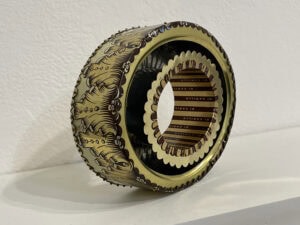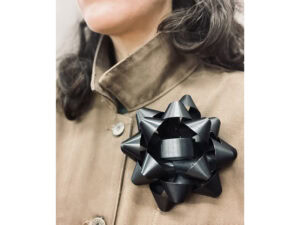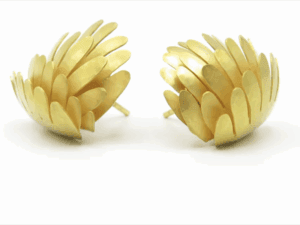This essay was developed from the lecture ‘Holding Objects: What It Means to Wear Jewelry: The Psychoanalytic Mechanisms,’ presented at the Facets of Meaning symposium at Tacoma Art Museum, June 28, 2009. A version of the talk was also presented at SOFA NY in June 2010.
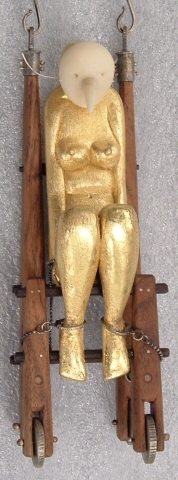
One of the most persistent questions I’ve sought to answer for myself is, why is jewelry so powerful? I have repeatedly heard a small set of concise, well-worn phrases: ‘Small-scale sculpture activated by the body’ or ‘the most intimate art form.’ I have seen pieces of contemporary jewelry which have utterly confounded me: why would someone put this on their body? The answers to both of these questions, it turns out, are complicated and emotional.
A number of years ago, I began discussing my observations and feelings about jewelry with my partner, Dr John Cardinali. He is a psychologist and psychoanalyst in private practice. We discussed the artists’ narratives, their personalities, the reaction of collectors and viewers to jewelry. I pressed him for the technical terms for some of the things I saw and experienced. Together, we have fleshed out the contours of this paper: a general introduction to the psychological underpinnings of the function of studio-art jewelry. Even with John’s patient and repeated explanations of the clinical terms of psychoanalysis, I must claim full and sole responsibility for any error and misuse of psychoanalytic terminology, and the stretching of veracity and application of clinical theory in service of art-historical methodology.
Psychoanalysis offers theories, organizing principles, models and terminology that help us understand how jewelry is utilized as a tool by individuals to navigate the complexities of the world and their relationships. Through a psychoanalytic lens, jewelry becomes an object that serves as a fulcrum in the dynamics between two people. The choice of psychoanalysis to understand studio-art jewelry is logical, insightful, thought-provoking, clarifying, and, for some, destabilizing for a number of key reasons:
- Jewelry is created and designed for the human body.
- The optimal position to view jewelry is while it is worn on another person’s body.
- Jewelry is most valued by artists and patrons for its ability to bridge two people. Wearing jewelry provides the moment, the object and the location for the activation of jewelry’s meaning.
- Some collectors strengthen their relationships to artists by continuing to support and collect their jewelry.

Freud described Dora’s condition as hysteria. The central fact of Dora’s situation was a sexual relationship with a man Freud identified as Herr K. Dora was sixteen at the time. Herr K. pursued Dora for more than a year before Dora’s father presented her to Freud for treatment. It is important to note that Herr K. was Dora’s father’s confidant. It is also significant that Dora believed, with considerable evidence, that her father was having an affair with Herr K.’s wife and that she was a pawn in her father’s relationships. According to Freud, ‘When she was feeling embittered she used to be overcome by the idea that she had been handed over to Herr K. as the price of his tolerating the relations between her father and his wife; and her rage at her father’s making such a use of her was visible behind her affection for him.’ (Gay 181) Herr K. visited Dora daily for a year and presented her with numerous gifts and affections.
During his treatment of Dora, Freud recorded repeated, significant observations about the prominence of jewelry. One of Herr K.’s gifts to Dora was an expensive jewel-case. And Freud recorded a number of telling statements by Dora herself:
‘Mother is very fond of jewellery and had had a lot given her by Father.’ (Gay 209)

‘A house was on fire. My father was standing beside my bed and woke me up. I dressed quickly. Mother wanted to stop and save her jewel-case; but Father said: “I refuse to let myself and my two children be burnt for the sake of your jewel-case.” We hurried downstairs, and as soon as I was outside I woke up.’ (Gay 206)
Freud also wrote: ‘Another time, again, she pointed out that evidently through the agency of Frau K., she had been given a present of some jewelry which was exactly like some that she had seen in Frau K.’s possession and had wished for aloud at the time.’ (Gay 205)
I have labored on this aspect of the case of Dora because at the very conception of psychoanalysis, Freud recorded five incidents in which jewelry was an object that defined relationships; symbolized complex interactions.
![Bernard Schobinger, Scherbern von Moritzplatz Berlin [Broken Pieces from Moritzplatz Berlin], 1983–84, antique crystal beads, television bulbs, German Coca-Cola bottle, silver, and steel wire, Museum of Fine Arts, Houston, Helen Williams Drutt Collection, gift of Gail and Louis K. Adler in honor of Fayez Sarofim Bernard Schobinger](https://artjewelryforum.org/sites/default/files/images2010/articles/holding-objects-psychoanalytic-mechanisms-wearing-jewelry/content/bernard-schobinger-moritzplatz.jpg)
Transference is a force that usually operates on the unconscious level. It is nearly constant force that informs relationships between individuals. Because no one comes to a relationship with a tabula rasa, transference is one of the primary mechanisms that determines responses to another person. An individual may become conscious of transference, which will provide understanding of his or her responses to dynamics within a relationship and may result in a diminishment or resolution of the transference feeling. This resolution results in the integration of a person’s past with their present experience. Applied to studio art jewelry, transference explains how jewelers share or transmit their thinking, their stories and their creative energy with patrons and anyone who views their work. Transference moves in one direction: from the artist to the patron or the viewer. One way to understand this form of transference is to use an idiom of monetization. We say that the patron ‘buys’ into this relationship. A museum acquires the work. Equally importantly, this idiom of ‘buy in’ is a critical act. Wearing jewelry is the process in which the wearer invests and announces an alliance with the artist, absorbing the artist’s intent and aesthetic and disseminates it into the world.
Marcia Macdonald’s If You Sit Still . . . You Can Take off the Mask (1999) is the work from the collection of Sharon Campbell (promised to Tacoma Art Museum) that triggered my interest in the psychological and psychoanalytic interest in jewelry. I find it of critical importance and significance that this neckpiece is completely atypical of Macdonald’s work. The figure – naked, masked, bowed and shackled – contemplates her situation. What must be stilled in order to remove the mask that hides or covers conscious awareness about her past? Macdonald is asking whoever wears this figure (and by extension whoever sees this figure) to share and experience the burden of her psychological conflict.
Karen Gilbert’s Protect (2004) functions as an amulet fashioned primarily with laboratory tubing and red glass beads, symbolizing blood. By wearing Protect, someone dons the artist’s hopes and desires for protection against illness and the artist’s awareness of the pain and suffering of other people.
The Shrine (1993) by Kiff Slemmons memorializes the hours and labors by women seeking identity as secretaries and clerks. For Slemmons’s generation, this labor offered freedoms and responsibilities unknown to earlier American women. The necklace encapsulates Slemmons’s ideas of labor and respect, which are then transmitted to those who see it. By wearing this work, the collector announces, proclaims or displays an affinity with Slemmon’s homage to the workers
With its reclaimed shards of trash and preserved crystal, Bernard Schobinger’s Scherbern von Mortizplatz Berlin [Broken Pieces from Moritzplatz Berlin] (1983–84) is a profound statement about the values and realties of pre-unification Germany, then an ironic statement about the former market in Berlin before the Allied bombings. When it was first created, the necklace was a way to recall the legacy of the divided city and nation. Today, this necklace provides a way to understand how Schoebinger understood the political and social structures of his time. By collecting this work from the artist, Helen Drutt supported not only the artist’s vision but also accepted his version of history, made manifest in the assembling of the shards and fragments of Berlin’s past.
The wearer presents studio art jewelry in the public sphere, giving many viewers their first opportunity to engage with the work of art. In addition to their immediate response to the object and the intent of the artist, the viewer receives an unending stream of non-verbal communication from the wearer. Jewelry completes the necessary triangulation between the artist and viewer through the body and actions of the wearer. This interplay, known as ‘intersubjectivity’ in psychoanalytic terms, must be understood as one of the key forces that underlies the communicative power of jewelry. The work of jewelry is a point through which the relationships flow, giving the artist a constant presence and role as arbiter.
Intersubjectivity is the idea that individual experience is determined by a process of reciprocal, mutual influence by another person. Intersubjectivity is fluid, constant, multidimensional and exquisitely context-sensitive with multiple layers of experience, oscillating between foreground and background and between figure and ground. Intersubjectivity is born out of the accumulation of past experiences and relationships
The display of jewelry on a wearer’s body provides the point of intersection between both the wearer and the artist and the viewer and the wearer. There are two sets of intersubjective relationships occurring simultaneously. The viewer addresses not only the artist’s iconography and intent (all of the experience, feeling, angst, tension, desire that fueled the creation of the work of art) but, perhaps more intriguingly, the viewer also confronts the relationships and experiences of the wearer. This exchange is extraordinarily charged because the wearer presents information about the relationship in the most intimate manner – placing the object directly on her or his body.

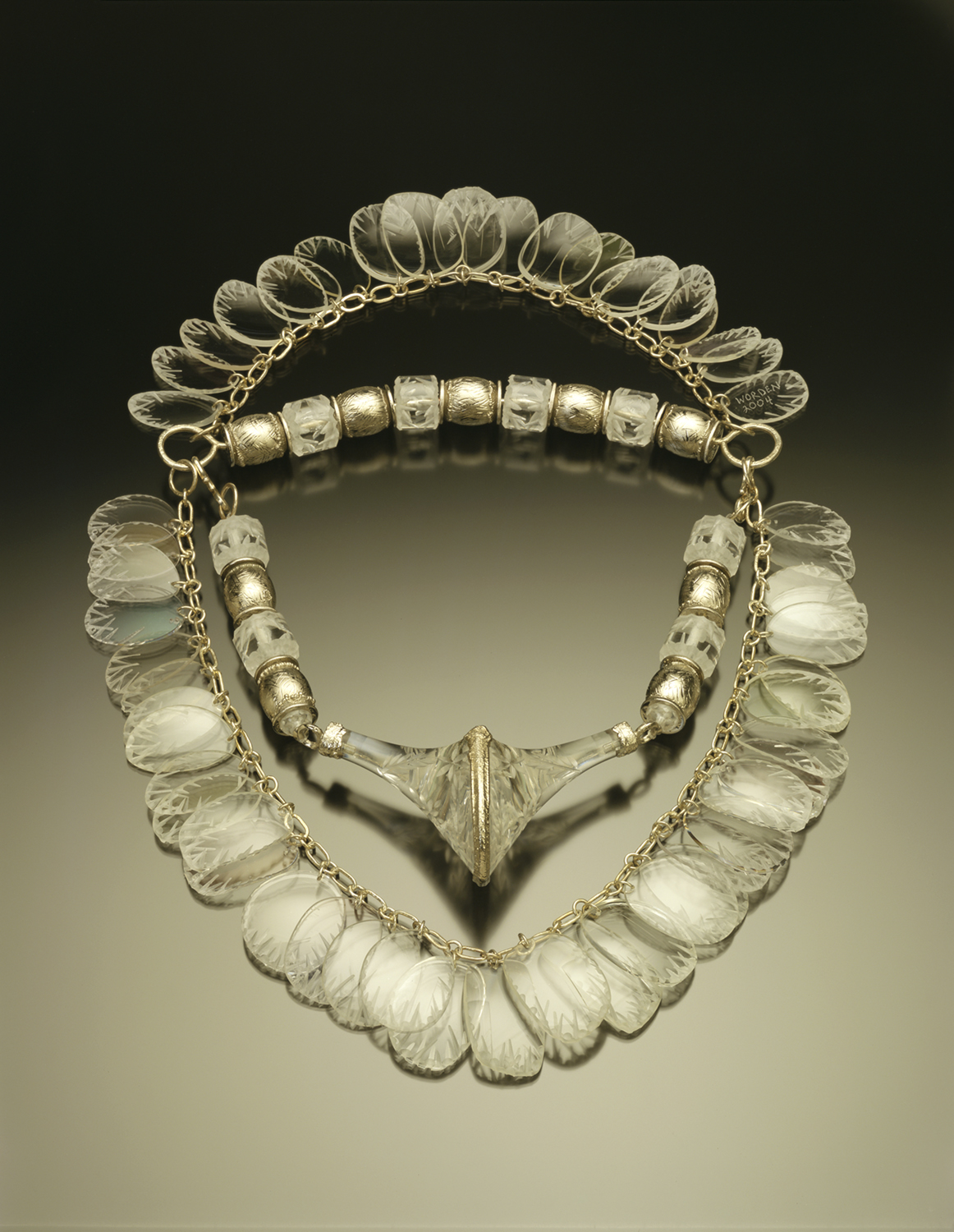
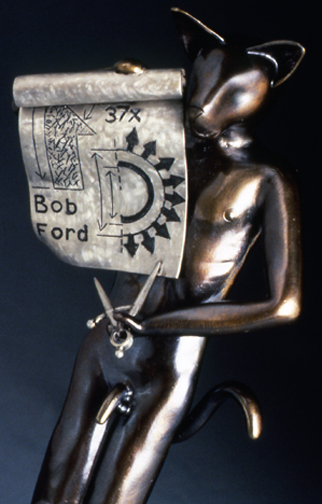
Like Slemmons and Worden, Keith Lewis expertly triggers intersubjectivity in much of his work. For Our Dear Bob (1995), Lewis remembers Bob Ford, a friend who was an architect and cat lover. Ford was also the first of Lewis’s acquaintances who died of complications of HIV/AIDS. This homage distills Lewis’s relationship with Ford for us and encourages us to remember all of the people we know who have passed away. Lewis’s symbols of the cats, the architect’s tools and the floor plan of the apartment the artist rented from the architect transmit the artist’s relationship to us. Because virtually every person who will see this work did not know Ford, we rely on our relationships and experiences and feelings to comprehend Lewis’s Our Dear Bob.
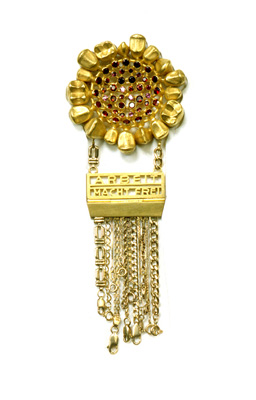
In terms of transference and intersubjectivity, I have discussed how jewelry serves as a conduit for personal exchange. The necklace, the brooch, the earring and the ring are the objects through which these interactions occur. I would like to change focus now to speak directly about the idea of the object itself. This consideration will move us firmly into the realm of ‘object relations’ theory. The point is not to describe a unified model to understand art jewelry from an object-relations perspective, but rather to identify concepts that help explain the function and role of jewelry and the artist.

The concept of ‘transitional object’ was formulated by Donald W Winnicott. (Spitz 08-509) In essence, the transitional object is used by a child in an effort to manage physical separation from the mother. An inanimate object becomes a surrogate for the mother by providing soothing and security in the mother’s absence. A teddy bear or cherished blanket are classic examples. The object is used in this fashion until the child has adequately internalized the mother’s soothing presence; at this point, the object loses its meaning.
Obviously, people who wear studio art jewelry are not seeking to find a soothing maternal surrogate (usually; but, a fanciful curator might imagine such dynamics unfolding). Yet the act of wearing jewelry has a strong resonance with the function of transitional objects. When a collector – especially when they commit to their first purchase – decides to wear the object, they are, at one level, seeking the permission of the gallerist or artist to wear the jewelry. Receiving this permission, the patron has the implied consent to represent the artist in public.
The notion of studio art jewelry as a transitional object, in formal psychoanalytic terms, opens the potential that the wearer/purchaser uses the jewelry as a tool to navigate the complexities of the world and strengthen their psyche. We may think of this act as a reciprocal situation: the artist needs the patron to carry the work into the world and the patron needs the object to wear. In both instances, jewelry is the surrogate for the absence of the other. In what might be described as a typical Winnicottian ko-an, he wrote: ‘When I look I am seen, so I exist.’ (Greenberg and Mitchell 192)
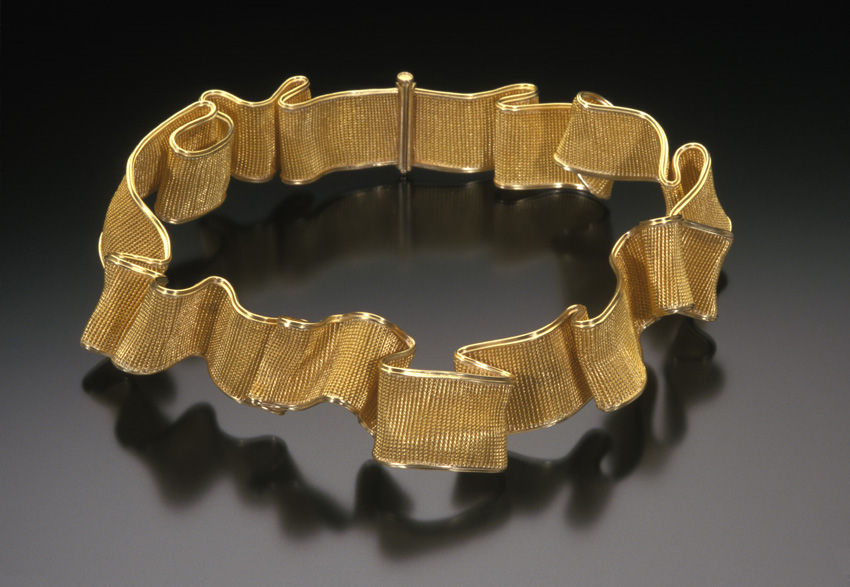
When an adult consumer, such as a collector of studio art jewelry – or a museum curator and director – actively responds to a work and incorporates it into their costume – or permanent collection – and, by extension, their psyche, one can find resonance with the effective function of a transitional object. The collector adopts the artist’s iconography to amplify powerful statements about themselves and their observations of the society in which they participate. The meanings adopted from the artist become guideposts or icons for the wearer.


This transgression with taste is one of the most appealing aspects of new European jewelry. Using sea-urchin spines as his primary motifs in Encrustarium 9 (2009), Sebastian Beuscher transgresses not only the line of appropriate media but also technique, formal composition and beauty. In art history, this broaching of decorum is labeled advancement and development. Generations and generations of artists must do this. For the first collectors of such material, they earn the coveted label as visionary supporters of artists. They are in effect maternal surrogates for artistic achievement.
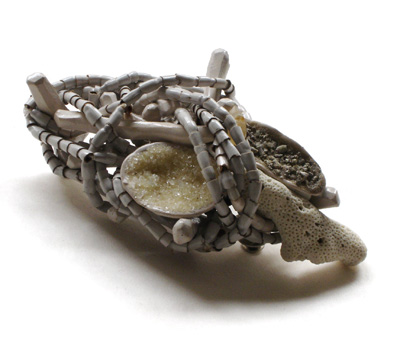
I want to stress that I am presenting only two terms from a clinical theory that has been continually modified over the course of the last seventy years. My point, aligned with object relations, is to emphasize again that we all developed from infancy and continually build on our experiences. In addition to the contentious history and evolution of object relations theory, the breast as object presents us with a series of interconnected provocations.
Primarily, jewelry is held or rests on a woman’s chest or bosom. This proximity reinforces the gender-specific functions of jewelry and provides a potent series of associations that amplify the artist’s intent and personal iconography. Breasts are clearly powerful symbols of maternal care, sexuality and consequently an important component of female development and a woman’s identity. A woman who wears jewelry on her breast creates a particularly interesting and complex psychological situation. From the beginning of life, the breast is in a real sense the provider of maternal care and nourishment. Breastfed infants can distinguish the smell of their mother’s milk by the first months of life and use this scent as a bridge for attachment and bonding. Positive and negative associations to the breast are developed based on the quality of mother-infant interaction.
Further, one must conceive of the emotional context between wearer’s breasts and viewer. This dynamic includes our deepest wishes and fears, the desire for love in both nurture and erotic form and conversely the reality of such love gone awry. Furthermore, this dynamic involves a dilemma created between the wearer and viewer. One the hand, the wearer communicates a wish to be seen and considered in a uniquely individual manner. On the other hand, the viewer must contend with propriety: the desire to look, to be stirred by the visual images while navigating an appropriate level personal privacy of the wearer.
Interestingly, this relational dilemma between wearer and viewer shifts in kaleidoscopic fashion depending on external context in which the wear and viewer meet, as well as each individual’s emotional state (intersubjectivity).
I recognize that jewelry also includes rings, bracelets, earrings and other possible sites for body adornment. Like the breasts, these areas are certainly capable of being consider erogenous zones, but this line of inquiry would take us too far afield for the point at hand.
The juxtaposition of jewelry and breasts has profound implications in understanding how jewelry functions. The interaction and physical proximity provides a platform to consider how the body itself infuses the objects with meanings of nurture and desire. A dynamic interplay ensues in which the wearer’s sense of self, the object and the viewer are combined, resulting in deeper consideration of the works through both the material aspects of jewelry and the manifestation of the internal worlds of the viewer and wearer.
Take, for example, this advert for the designs of Stephen Webster. Youth and beauty are used to sell commercial jewelry. The advert precisely targets our desire to become wealthy, sensuous, and young. The advert promises that if we have this necklace, we too can have this shapely bosom and become, magically, this young and beautiful, too. To illuminate the sense of urgency for this consumer commodity, the photographer splashed light across the model’s bosom and, almost inadvertently, illuminates the jewelry. The model’s breasts become the platform for the tension and conflict between good and bad desires. Theoretically, we are faced with the identical struggles of Klein’s infants.
Let us now return to the neckpiece by Marcia Macdonald. Imagine this work hanging on its slender chain resting, protected, between two breasts. The power and importance of the artist’s statement grows exponentially. All of our associations with nurturing and with the negativity associated with the maternal swirl turbulently.
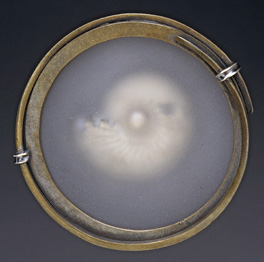
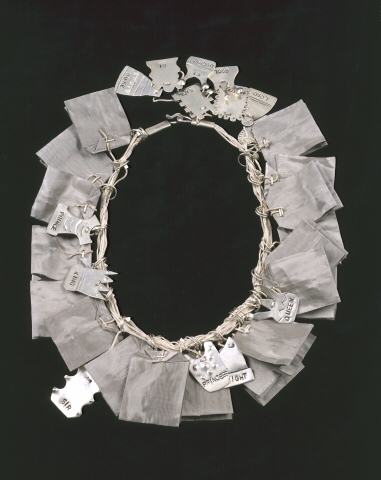
In the Kleinian model, infants advance as they learn to moderate or mediate feelings of separation, anxiety, desire. Healthy infants learn to ‘depress’ these negative feelings and comprehend the entire maternal presence. Throughout our entire lives, we balance these negative and positive conflicts; we suppress and encourage desires. To my mind, good jewelry should trigger a conscious awareness of these conflicts. Jewelers have this extraordinarily powerful tool to tip, to jiggle, to upset, or to reactivate an individual’s equilibrium, or the steady state of the ‘depressive position.’ They should make us consciously rethink our core beliefs and expectations about ourselves and the world around us.
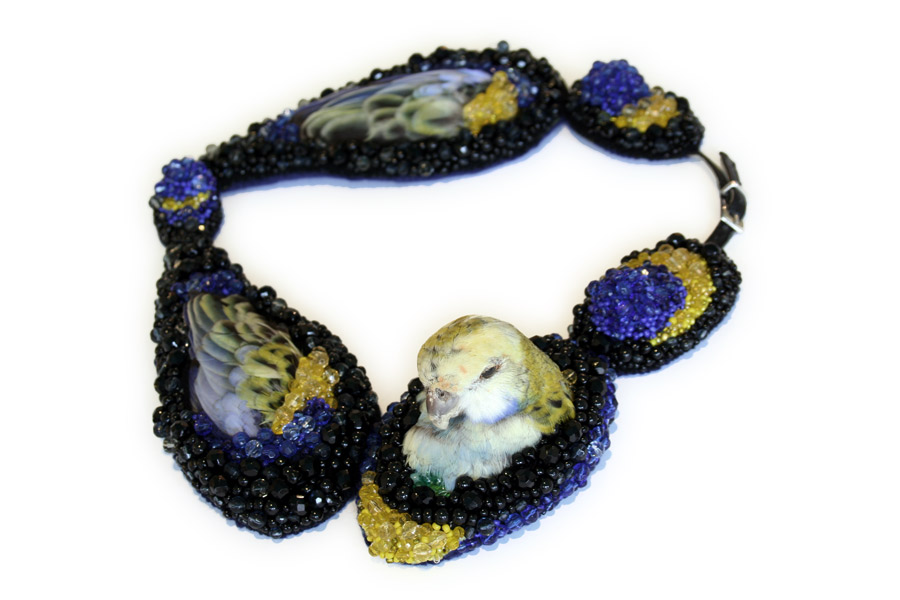
In terms of the ‘paranoid/schizoid position,’ Keith Lewis obviously goes for the jugular in Choke Chain (2005). Pun intended. He wrote in his artist statement: ‘In this case the term “choke chain” takes on a new, aggressively sexual meaning because the jewel on the chain is a miniature – but nonetheless rather prideful and assertive – penis which emerges from the neck in a posture similar to the way that an erect penis thrusts and bobbles from the groin. Surprisingly hard to ignore, just like the real thing . . .’ (Lewis, 2005)
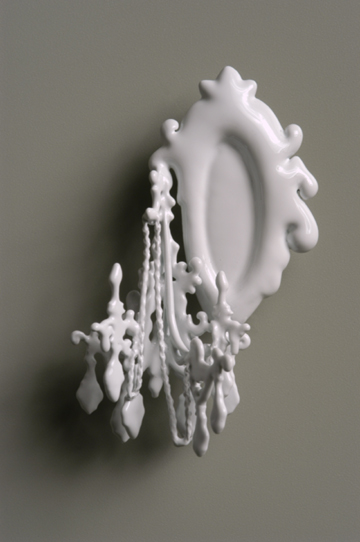
The use of genital imagery is not the sole province of men. Anya Kivarkis incorporates art historical references, feminist perspective and the sensuous interplay of curves and countercurves to interrogate our social emphasis on beauty, wealth and gender roles. Like Lewis’s phallus, Kivarkis’s vaginal reference in Untitled (2006) becomes more potent in its adjacency to the breast. It is the embrace of the art-historical knowledge and the attention given to the tension between feminine forms and feminist art histories that is important for Kivarkis and her audiences. Her brooch celebrates the history of decorative objects; slides into the ‘gold frame’ of art history by referencing surrealist painting and sculpture, and the gendered reading of such histories.

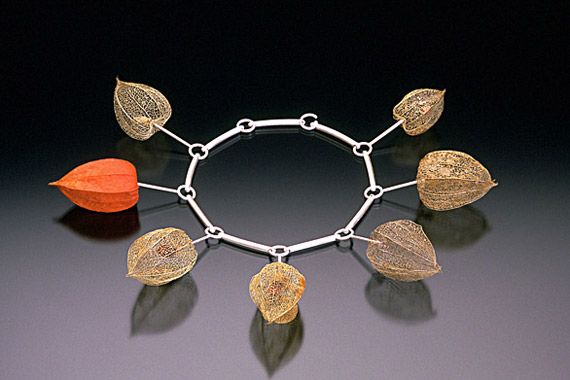
Through numerous examples, I have sought to illustrate how jewelers activate four key psychoanalytic concepts in their work. I hope the title is now understood: the action of placing jewelry on the body (holding) and the fundamental concepts of object-relations theory (objects – in terms of the physical work of jewelry or the artist’s intent). These four concepts are rarely found outside of academic and clinic applications. They are taught as theory to students of contemporary psychoanalysis and applied in clinical settings during therapy.
For wearers of studio jewelry, these four concepts usually trigger unconscious actions and reactions. More generally, interactions between the wearer and the viewer are more conspicuously governed by tensions and dynamics that are easily identified in the moment. More obvious, but no less important, is the role of narcissistic motivation. Because of the immediacy of forces such as narcissism, the four core concepts of transference, intersubjectivity, the transitional object and the paranoid/schizoid positions work undetected. Yet, all of the forces operate simultaneously and are inextricably linked.


Sometimes, like Natalya Pinchuk’s felt creations such as In Full Bloom (2006), the desire to be seen is self-evident. Other times, the force operates more quietly. With Ron Ho’s Vanished Wishes (1990), the intent focuses on those lost to HIV/AIDS and the artist’s identification with missing friends and colleagues as well as the political activism. With the precise work of Bruno Martinazzi, narcissism requires that the wearer identify with his representation of the elegant geometry of the Assumption and one-point perspective as developed in the early Italian Renaissance. In this exchange, the wearer not only validates Martinazzi’s explanation and depiction, it also suggests that the wearer has knowledge of the mathematical and religious systems. Because religious themes are so personal, this act of near piety (aesthetic or Roman Catholic) becomes a very distinct and unmistakable statement.
![Bruno Martinazzi, Ommaggio a Piero [Brooch inspired by Piero della Francesca’s Annunciation, 1467–68], 2005, white gold, yellow gold Bruno Martinazzi](https://artjewelryforum.org/sites/default/files/images2010/articles/holding-objects-psychoanalytic-mechanisms-wearing-jewelry/content/bruno-martinazzi-hommage.jpg)


